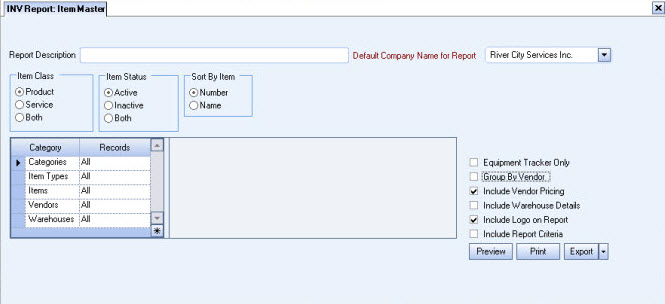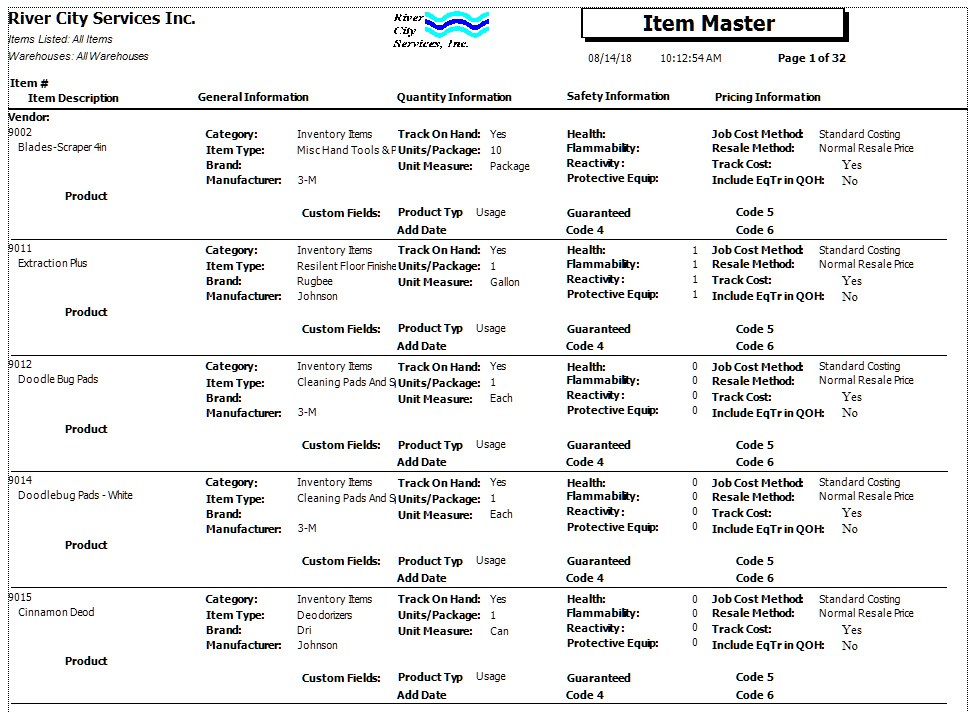Overview
The Item Master Report prints a list of inventory items based on the specified sort criteria. The list contains the information entered on the Item Master File record. There are multiple options available for sorting the report.

Key Functionality
Type a description to name the report. This description prints above the Report Title.
Available for Clients using the Multi-Company feature. The Default Company Name for Report is populated from the Company Setup screen. The list contains all companies you have permission to access. The default company prints on every page of the report.
If the User has permission to only one company, then just that one company will display in the list. If the User has permissions to more than one company, the list will contain all companies the User has rights to PLUS the default reporting company. For more information see Learning about WinTeam Reports.
Use the Item Class option group to include active products, services, or both for reports.
- Click Products to include only products on the report.
- Click Services to include only services on the report.
- Click Both to include products and services on the report.
Use the Item Status option to include active items, inactive items, or both for reports.
- Click Active to include only active items on the report.
- Click Inactive to include only inactive items on the report.
- Click Both to include active and inactive items on the report.
Use the Sort By option to sort report data by Item Number or Item Name.
Click Number to sort report data by Item Number. Click Name to sort report data by Item Name.
This option group displays when the Group By Vendor check box is selected.
Select to sort the report by Vendor Number or Vendor Name.
Categories
Use the Categories option to filter the report data by Inventory Categories.
Select All to include all Inventory Categories on the report.
Select Pick to define specific Inventory Categories for the report. When you select Pick, a list of Inventory Categories displays. Select the check box next to each Inventory Category to include on the report.
Item Types
Use the Item Types category to select the inventory Item Types to include on the report.
Select All to include all Item Types on the report.
Select Pick to define specific Item Types for the report. When you select Pick, a list of all Item Types display. Select the check box next to each Item Type to include on the report.
Items
Use the Items category to select the Inventory Items to include on the report.
Select All to include all items in the Item Master File.
Select Range to define a range of item numbers for the report. When you select Range, the range fields display. Type the beginning item number in the From field and the ending item number in the To field.
Select Pick to define specific Items for the report. When you select Pick, the Items list displays. Select the check box next to each Item to include on the report.
Select Create to define your own list of Items. When you select Create, a small grid displays to the right. Enter the Item Numbers you want to include in the list, or use the Lookup to locate the Item Numbers.
Select Exclude to identify records that should not be included. When you select Exclude, a small grid displays to the right. Enter the Item Numbers you want to exclude in the list, or use the Lookup to locate the Item Numbers.
Vendors
Use the Vendors category to select the Vendors to include on the report. (On the HR: and INS: Benefit Insurance/Other Analysis Reports, this Category is available when the Report Type is Vendor Billing.)
Select All to include all Vendors.
Select Range to define a range of Vendors for the report. When you select Range, the range fields display. Type the beginning Vendor Number in the From field and the ending Vendor Number in the to field, or use the Lookup to locate the Vendor Number.
Select Pick to define specific Vendors for the report. When you select Pick, the Vendor list displays. Select the check box next to each Vendor to include on the report.
Select Create to define your own list of Vendors. When you select Create, a small grid displays to the right. Enter the Vendor Numbers you want to include in the list, or use the Lookup to locate the Vendor Numbers.
Select Exclude to identify records that should not be included. When you select Exclude, a small grid displays to the right. Enter the Vendor Numbers you want to exclude in the list, or use the Lookup to locate the Vendor Numbers.
Warehouses
Use the Warehouses category to select the Warehouse Locations to include on the report.
Select All to include all Warehouse Locations on the report.
Select Pick to define specific Warehouse Locations for the report. When you select Pick, a list of Warehouse Locations displays. Select the check box next to each Warehouse Location you want to include the on the report.
Select the Equipment Tracker Only check box to include only items that are being tracked through Equipment Tracker.
Select the Group by Vendor check box to Group items by Vendor.
If this is selected, the Sort By Vendor option group is available.
Select the Include Vendor Pricing check box to include
Select the Include Warehouse Details to include all information from the Item Master File (Warehouse Details tab).
Select the Include Logo on Report check box to print the company logo on the report. This check box is selected or cleared by default, based on the option selected in SYS:Defaults. However, you can modify the setting on each report.
Select the Include Report Criteria check box to include a list of the report options selected for this report. The Report Criteria page includes any ranges specified and each Category/Record selection made for the report. This check box is NOT selected by default.
Note: Multi-Company—WinTeam looks to the Job's Company logo to determine which Company logo to use on the Work Ticket Report and Work Tickets.
Click the Preview button (or use the shortcut key, ALT + V) to view before printing.
The Preview button is available for Detail and Summary Report Types.
Click (or press ALT + P) to send the report to your default printer.
The Print button is available for Detail and Summary Report Types.
Click the Export button (or press ALT + X) to export to a specified format. Reports may be exported to Adobe Acrobat (PDF), Excel, Comma-Separated Values(CSV), Grid View, and E-mail (for premise-based clients only).


